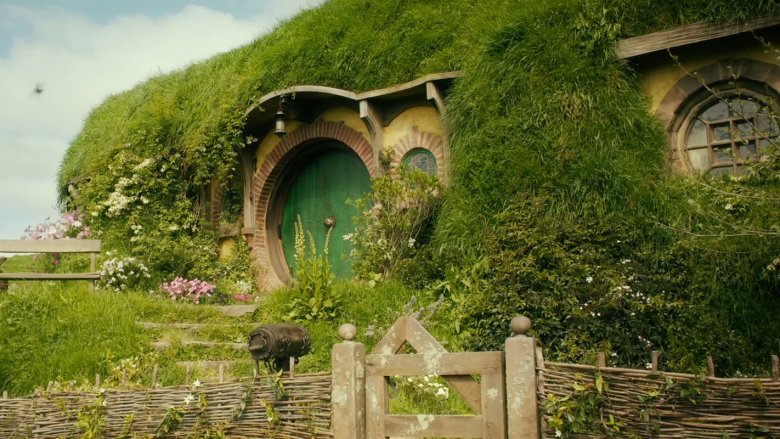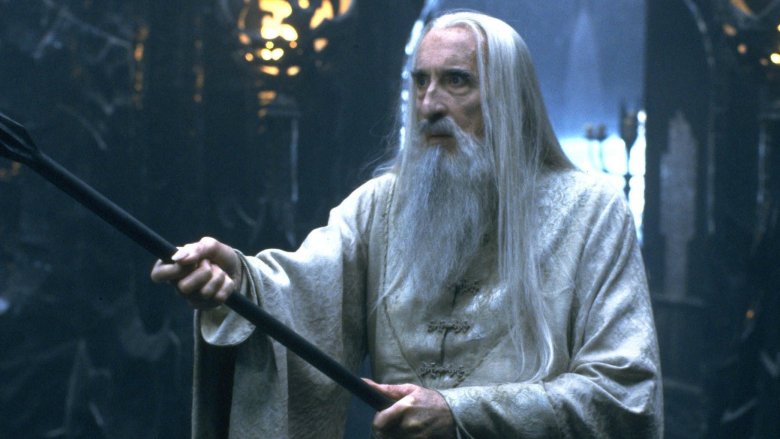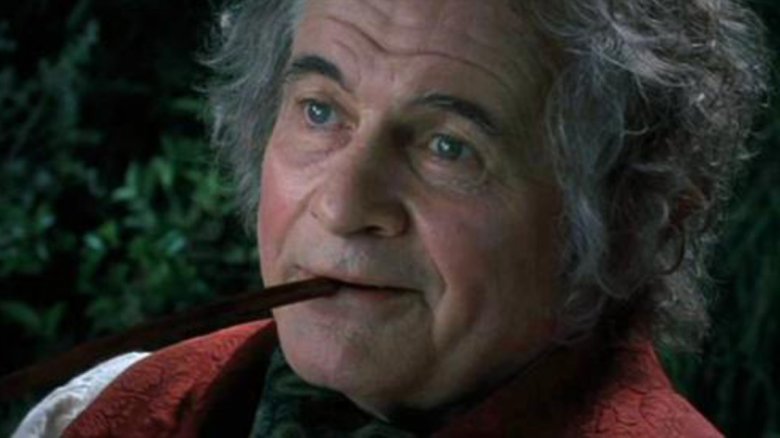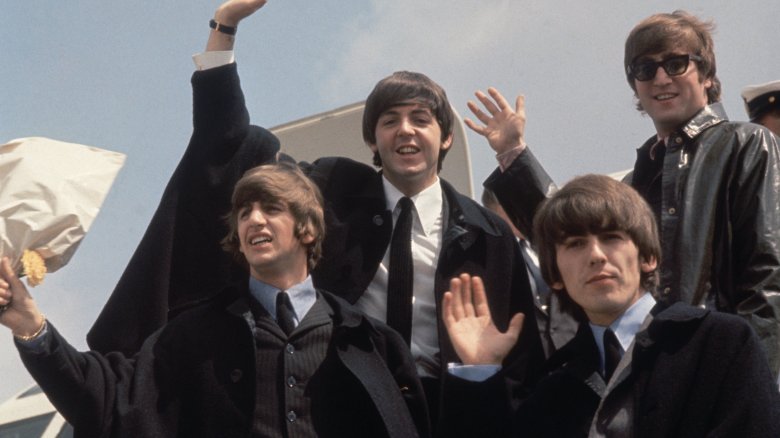The Untold Truth Of The Lord Of The Rings
We may receive a commission on purchases made from links.
From the printed page to the silver screen, J.R.R. Tolkien's monumental trilogy The Lord of the Rings has long held a special place in the hearts of old and young alike. The epic three-part fantasy, brimming with goblins, elves, dwarves, and, of course, hobbits, has become a common part of the modern vernacular, sparking the imagination with its vivid imagery, moving readers with its deep character development, and providing a blast from the past with its overall archaic voice and style.
It's no surprise that a work of this magnitude involved years and even decades of Tolkien's life — and decades later, a massive commitment from director Peter Jackson and his cast and crew. The backstory of the novels as well as their cinematic counterparts are riddled with a plethora of exciting factoids that make the entire Middle-earth experience that much better. From the books that revolutionized the modern fantasy landscape to the films that followed, here are some of the best pieces of trivia to ever surface from Tolkien's beloved literary classics and their adaptations. This is the untold truth of The Lord of the Rings.
A surprise return to Middle-earth
As Tolkien explained in his foreword to The Fellowship of the Ring, the tale of The Lord of the Rings "grew in the telling," with the author discovering it as he went along. This was largely due to the fact that the story found its beginnings as a sequel to Tolkien's previously published book The Hobbit. The thing is, The Hobbit was initially supposed to be a one-off event. In a letter to his publisher, he discussed how he was struggling with "the sequel," and it was only connected to his other Middle-earth writings by virtue of an occasional name-dropping or character crossover like Elrond, the son of Earendil the Mariner.
However, the success of The Hobbit made the demand for more adventures so loud that a sequel was inevitable. Even as the new book slowly took shape, though, it continued to be seen as a sequel to The Hobbit rather than its own story. For example, Tolkien's close friend and literary sounding board, C.S. Lewis, was known to refer to the work simply as the "new Hobbit." Once Tolkien settled on making Bilbo's ring the connection point from one book to the other, the "new Hobbit" grew into a massive story that stood on its own.
Too short or too long?
It didn't take long before The Fellowship of the Ring alone dwarfed The Hobbit in size. It turns out, though, that the very length of the story was actually one of Tolkien's main challenges that he set himself in its composition. The author pointed out in the foreword that his "prime motive was the desire of a tale-teller to try his hand at a really long story that would hold the attention of the readers," adding that some readers considered his work "boring, absurd, or contemptible." However, he followed this up by explaining that the most critical defect of the whole story, in his opinion as well as others', is the simple fact that "the book is too short."
Tolkien didn't always feel that way about the story, though. In a letter to his editor in December of 1939, he wrote that he feared that the story was "growing too large." It wasn't a temporary feeling, either. In a letter to his son five years later, he reiterated, "I'm afraid I have made a great mistake in making my sequel too long and complicated." Fortunately for his readers, he didn't let the desire for brevity diminish the growing size and scope of the story.
Unfinished Tales
Middle-earth wasn't built in a day. In fact, Tolkien started creating his world in 1917, when he composed early drafts of The Fall of Gondolin and continued until his death over half a century later. During that time, The Hobbit and The Lord of the Rings were published (the former in 1938 and the latter over 15 years later), but Tolkien's lifelong labor also yielded a treasure trove of other stories. Many of these were collected into his epic The Silmarillion, while some found their way into other publications, including Unfinished Tales. This collection of literally "unfinished stories" filled in many of the gaps of knowledge that had been left out of The Lord of the Rings.
While many scenes, particularly from the extended versions of Jackson's films, come across as invented elaborations of the original manuscripts, it turns out that many of them find their origin in Unfinished Tales. From Isildur being ambushed by orcs and losing the ring in the Anduin to an account of the death of Theodin's son Theodred at the Battles of the Fords of Isen and the story of the Black Riders' hunt for the ring, Unfinished Tales was doubtless a huge factor in helping to round out a great deal of the story as it was translated from book to script.
A distraction
While the world at large may see The Lord of the Rings as the pinnacle of Tolkien's writing, in many ways the story ended up being more of a bother than anything else to the busy Oxford don. In a letter to his publisher in February of 1938 he explained that "for the moment the story is not unfolding," blaming the issue largely on "squandering" too much material on The Hobbit. In his foreword to The Fellowship of the Ring, he explained, "I had many duties that I did not neglect, and many other interests as a learner and teacher that often absorbed me." And then, of course, there was the rather hefty distraction of World War II, which happened to overlap neatly with the period of time that he wrote The Lord of the Rings (1936-1949).
But even when war, work, and family didn't call him away, Tolkien's greatest passion was still reserved for other works. In another letter to his publisher later in 1938 he said his mind was "really preoccupied with the... The Silmarillion." While the world clamored for more adventures with Hobbits, Tolkien's mind swirled with events like the epic Tale of Tinuviel, the fall of the elvish city of Gondolin, and the foundation of Middle-earth itself by Illuvatar and his mighty Valar. In many ways, The Lord of the Rings seemed to be little more than a tangential story to what really mattered to the author.
Sir Christopher Lee
From countless acting accolades to an epic military career in World War II, to his passion for heavy metal music, Christopher Lee was extraordinary — and also head over heels about all things Middle-earth. Lee read Tolkien's books every year, and was so passionate about the story that when he heard Peter Jackson was putting together a film adaptation, he wanted in.
Unfortunately for the esteemed Englishman, his greatest desire wasn't to play Saruman the White, but rather Gandalf the Grey. While he didn't get to fulfill that particular goal, his presence as a seasoned Tolkien aficionado was invaluable. While some actors came into the project still playing catchup with the source material, Lee's annual return to Middle-earth ensured that he knew exactly where the story was going at all times. He also had the distinguished honor of being the only person on the entire set that actually had met Tolkien in person. And we're not talking about some rabid fan surprise visit to the professor's home: He accidentally ran into the author when visiting the Eagle and Child, one of Tolkien's favorite watering holes because.
Aragorn drama
While Viggo Mortensen's portrayal of Aragorn has been stamped on the hearts and minds of Middle-earth fans, it turns out Mortensen was nowhere to be seen when the cameras started rolling. Instead, it was none other than Stuart Townsend who initially donned the Strider persona. However, a mere three days into filming, Townsend left the project and Mortensen was tapped to jump into the role. That's right: Mortensen wasn't officially brought in to play Aragorn until three days after filming started.
As the dust settled, it became clear that the switch simply came about because Townsend ended up coming across as too young for the virile yet aged king in exile — a feeling that, according to Jackson, Townsend shared. That didn't make matters easy for the incoming Mortensen, though. He had never read the books before that point, not to mention the fact that he was jumping into a key role next to actors that had been prepping for months. One thing he had going in his favor, though, was that he was already familiar with many of the old Nordic sagas that had originally inspired Tolkien.
A towering dwarf
John Rhys-Davies played a very memorable Gimli the dwarf, rife with humor and heartwarming brotherly love. However, it may come as a surprise that the actor was hardly the best fit to play the diminutive character — physically speaking, anyway. Davies wasn't just a big guy, he was also tall. In fact, he was the tallest member of all the fellowship actors. Any time he was next to a Hobbit actor, the height difference was actually quite appropriate, but it was tricky business filming many of the scenes that involved taller characters.
Not only was his height an issue, Davies' presence on the set in the first place was questionable. The man seriously debated getting involved in the project at all, stating in an interview with Digital Spy that he "didn't want to spend three years in prosthetic and make-up on a film that was going to fail." It was Peter Jackson's skill as a director that convinced him that the project was actually worth getting involved in. While Davies may have initially waffled over the decision, in retrospect, it's hard to imagine any other grizzled face in the role.
Doubling up
While Ian Holm is lovingly remembered for his portrayal of Bilbo in both The Lord of the Rings as well as a reprised role in the later Hobbit trilogy, it turns out that playing hobbits was old hat for the veteran actor before he ever stepped foot on any of Jackson's sets. We all remember him playing the old bachelor of Bag End, but his Middle-earth debut actually came in the form of a much younger character — none other than Bilbo's younger cousin, Frodo.
Holm was cast as the ring bearer in a BBC radio broadcast of The Lord of the Rings in 1981. You can actually hear him singing the Man in the Moon drinking song in the Prancing Pony before accidentally slipping the ring on his finger here. While the radio broadcast was a nice way to get his oversized, hairy hobbit feet wet, there's no doubt that he ratcheted things up a notch when he joined Jackson's mammoth cinematic production.
Getting animated
While we're all familiar with Peter Jackson's monumental trilogy, savvy fans know that they aren't the first film adaptation of Tolkien's saga. In 1978, animator Ralph Bakshi directed a Lord of the Rings that brought The Fellowship of the Ring and part of The Two Towers to life on the big screen. While the film did quite well, bringing in tens of millions of dollars, in the grand scheme of things it didn't capture the saga quite as thrillingly as the Jackson films that followed two decades later.
Bakshi, however, disagrees. In a 2002 interview, he scoffed at the idea of watching Jackson's adaptation, wondering "Who needs the aggravation." Jackson clearly used Bakshi's animation as inspiration for many shots in his own film — and Bakshi wasn't happy about this either, pointing out that it wasn't properly acknowledged while Jackson denied it had any bearing on the issue until "very late in the game."
One thing the two directors had in common? A love of the source material. "The books are absolutely perfect," said Bakshi. "There isn't a sellout moment in them. The characters and setting, are staggering. Nothing like it in fantasy can touch it."
The Serkis effect
In an era when motion-capture characters have become as commonplace as they are breathtakingly realistic, it's easy to forget one of the greatest breakthroughs in mo-cap history: Gollum. Peter Jackson and company faced a challenge when it came to adapting Smeagol to the silver screen. He was integral to the storyline, required a lot of close-up screen time, and was practically buck naked, so you couldn't settle for good facial expressions and throw an overcoat over the character to hide the rest.
Weta Digital, the New Zealand-based company co-founded by Jackson, brought Gollum to life in the Lord of the Rings trilogy as well as the Hobbit films that followed. But while they were focused on the technical aspects of the job, what they really needed was an actor brilliant enough to play the character on the set. Enter Andy Serkis, whose performance was one for the ages as he acted out many of Gollum's scenes while covered from head to toe in motion capture gear.
The mingling of Weta Digital and Serkis was magical, to say the least, delivering one of the first truly believable motion capture performances in cinema history. It was a benchmark and an inspiration that spurred the development of countless other characters, like Marvel's Thanos and Caesar from Rise of the Planet of the Apes. The only question is, why is it still so difficult to nominate Serkis for an Oscar? The man has to have earned one by now.
The Fab Fellowship that never was
Peter Jackson is inextricably linked to The Lord of the Rings for the long haul. Even Amazon's grand plans for a series set in Middle-earth couldn't get started without an effort to incorporate Jackson's vision into their new project. However, before Jackson, there were the Beatles. According to Peter Jackson, who was filled in by none other than Paul McCartney at the 2002 Academy Awards, the Beatles actually tried to get the rights to make The Lord of the Rings films themselves. And they didn't just want to produce them, they wanted to star in them as well.
Picture this: the wise wizard George Harrison the Grey steps into the scene to tell Frodo McCartney that he must go with his faithful gardener, Ringo Starr, to the Crack of Doom, all the while keeping a sharp eye out for that villainous rogue John "Gollum" Lennon. No joke. (Okay, the names wouldn't have been changed, but they really did want the roles.) The icing on top? According to some rumors, they wanted it to be a Stanley Kubrick production. Not surprisingly, Tolkien shot the rather wild idea down.
Bingo Baggins finds a Ring
Tolkien's writings went through massive revisions over the course of his life. While this is especially true for many of the stories that ended up in The Silmarillion, it also affected The Lord of the Rings as it unfolded. One of the most entertaining examples is the short-lived character of Bingo Baggins.
According to David R. Collins' J.R.R. Tolkien Master of Fantasy, when Tolkien initially began to write what eventually became The Fellowship of the Ring, he created the character of Bilbo's son Bingo to carry on the story. However, this wasn't much to his liking, so he changed the character to Bingo Bolger Baggins, the nephew of the hero of The Hobbit. The thought was initially that Bingo would find a ring as his father/uncle had beforehand. As the story grew and became more serious, Tolkien eventually decided to change the name to the familiar Frodo that we all know and love.
Hundreds of Hobbit feet
In an era when everything can be done with CGI, it's hard to remember that movies, especially fantasy movies, have historically needed a boatload of costume designers and make-up specialists in order to bring everything together in a believable way — and the sheer scale of the workload shouldered by the crew for the Lord of the Rings films bordered on ridiculous. It's estimated that a whopping 1,800 pairs of prosthetic Hobbit feet were created throughout the course of filming for the four main characters alone.
And the fun doesn't stop there, either. In addition to the footwear, swordsmiths (yes, those still exist) were hired to create real swords for the set, while 10,000 arrows were made for The Fellowship of the Ring alone. The piece de resistance comes in the form of 12 kilometers of pipe that were sliced up into 12.5 million rings in order to create the chainmail pieces that so many characters sported throughout the saga. Creating the armor literally rubbed the fingerprints off the designers tasked with the job.
Balrogs don't have wings
The debate over whether Tolkien's infernal monsters come equipped with a set of wings has raged for years. The films depict the fiery demon with large leathery wings that tower menacingly, adding to an overall fearful demeanor. However, in the book, all that is said is that "His enemy halted again, facing him, and the shadow about it reached out like two vast wings." The use of the word "like" implies that the description is referring to the general darkness that the creature is wreathed in. Not actual wings.
In addition to this, when Gandalf finally defeats the Balrog, he knocks him off the mountainside. The same event takes place in The Silmarillion when the hero Glorfindel duels a Balrog on a mountain and both are destroyed in a fall. If they had wings, the clear solution should have been a quick, winged flight to safety. On the contrary, whenever Balrogs are mentioned as "flying" or having "wings" it is used as a form of imagery, which is Tolkien's bread and butter. At the end of the day, the thought of Balrogs having wings is pretty sweet, but the desire for wings can't trump the fact that nowhere in Tolkien's writings does it explicitly state that they exist.














